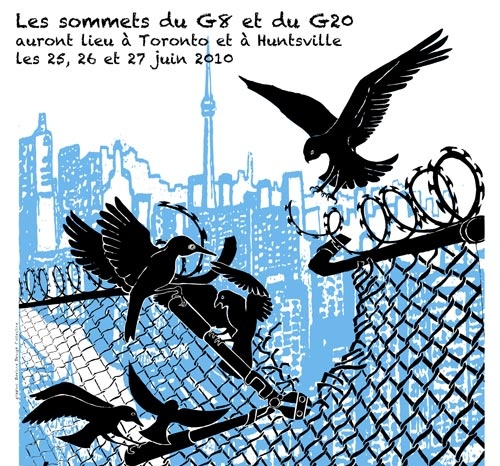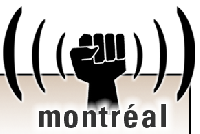 |
 |
 |
 |
 |
 |
|
 |
 |
 |
 |
 |
 |
 |
Régions du Québec |  |
 |
 |
|
 |
 |
|
 |
 |
|
 |
 |
 |
 |
 |
 |
Rubriques |  |
 |
 |
|
 |
 |
|
 |
|
 |
 |
 |
On Tactics
After Seattle, Quebec, Prague, Göteborg and Genoa the discussion violence vs. non-violence continues and seems far from being resolved.
If the discussion has to be conducted we better look at, and understand the tactics of the rulers’ police forces. It might be helpful to setting up or changing the movement’s tactics.
After Seattle, Quebec, Prague, Göteborg and Genoa the discussion violence vs. non-violence continues and seems far from being resolved.
The first question to ask is if what the WTO, IMF, G8, EU, etc is doing inside those closed meetings that is so good to humanity, why they need that massive police forces to protect them?
The answer, of course, is that the politicians gathering in Seattle, Quebec, Prague, Göteborg, Genoa and later this year in Brussels are not "leading." They are being lead by corporate interests that are, by their very nature, contrary to enlightened and pragmatic public interest.
Everybody agrees that changes will not be easy to get, but the idea on tactics of how to get these changes differ. Some people think that sitting at the same table with these leaders can change something. Others think that a deep reform of capitalism is impossible if not even objectionable. Why reform a system that proved to be cruel, reckless and violent to the majority of the world population? Capitalism will only survive by polishing the sharp edges, doing more than that will kill capitalism.
If the discussion has to be conducted we better look at, and understand the tactics of the rulers’ police forces. It might be helpful to setting up or changing the movement’s tactics.
Since the Seattle top, police and repression actions have turned more violent and they become harder on every new top. In Genoa shooting against demonstrators was not a première, it happened before in Göteborg (luckily no one was killed) and the Göteborg responsible police chief does still not regret the shooting. Other new police tactics are the use of containers (tested also for the first time in Göteborg) and the total secluding of a territory. But… these are the most visual parts of the police tactics.
Weeks before the meeting already the mass media informed us about what was done in Genoa to “make the G8 Conference a success”. Success for whom? Certainly not for the ten thousands of protesters. Actually we saw the fences being build, the containers being stacked and heard the news about the ordered 200 body bags. Suddenly bombs exploded around Genova and evidently the protesters against the G8 were incriminated. (What is today the result of the investigation on these bombings? Never heard anything since). Representatives of police forces from Europe, the US and Canada gathered together in Genoa to prepare the “confrontation”. Frontiers were closed in infringement of the Schengen agreements and “black lists” of “suspected” people were compiled, e.g. the German government had established a database to track over 2,000 activists involved in the anti-globalization movement. People travelling were detained at the frontiers and even repatriated because they were a “security risk”.
The psychological warfare of the police had only one goal: make suspicious any protest against the G8 Summit and prevent any action in the Red Zone.
Each contact set up with the demonstrating organisations during the preparatory time of the Summit was violated. The police had chosen total confrontation with the demonstrators and the contacts were only used to hide the real goals. Preventive police raids before any protest or violence has been spotted, a tactic blown over from the United States, have been carried out, e.g. in the Carline Stadium on Tuesday July 17. The argumentation is always the same: suspicion of the presence of weapons. Coincidentally it happens to be the only reason for the Italian police to be able to make a search without any warrant. Contrary to what is told, nothing is ever found, except “arms” like Swiss knives, etc… but that doesn’t matter, the goal is reached: disorganising the organisation and start of chaos in the streets due to protest against the raids.
The fact of the Black Bloc being infiltrated by police provocateurs has been documented since. Police used in fact the Black Bloc and its tactics to undermine the whole movement. Vandalisation was used as an excuse to criminalise the whole movement. The vandalism occurred on Friday (and was mediatised on all television stations over the world as the few hundreds of Black Bloc affiliates being the whole movement) and resulted in the death of one young man, Carlo Giuliano.
On Saturday again, the Bloc tactic was used namely by police provocateurs smashing windows and looting before the beginning of the march. Police didn’t interfere untill one or two hours later the real march started. They had their ideal alibi to tear-gassing and attack the demonstration. This happened without first demanding the demonstrators to disperse or any other warning. Why then wonder if some of the provoked peaceful demonstrators choose to defend themselves? Others who tried to withdraw from the scene of violence were not allowed to retire through the side streets, they were even pursued on the beach.
Another tactic always used is to form a joint block of police, government (politicians) and the media. As we already described above the politicians and the media are used in the preparatory stage to pass a certain message. International police co-operation is set up and “black lists” are made without protest from “democratic” politicians. Official G8 press coverage is only accepted from friendly media. Demand of press accreditation from supposed “G8 non-friendly” media representatives have been rejected by the Italian Foreign Ministry. Indymedia e.g. did not get an accreditation, but also other “regular” media were not always accepted. Despite this narrowing of press freedom, the Italian government claimed the Summit was open and democratic.
Carlo Giuliano died on Friday. And although in its first declaration the police claimed he died from injuries by stones throwed by somebody, later police theory of self-defence was immediately accepted by the media as well as their information Carlo Giuliano being a squatter, drugs addict and petty thief with a criminal record. This all probably in an attempt to make his death more “acceptable” to the “respectable” population. Most of the media said that the Genoa Summit had "been overshadowed" by street violence.
Only through the actions of some established media, like La Republica in Italy that immediately claimed the police was lying, and the “airing” of testimonies and photos of the killing on the internet by “irregular” media as Indymedia, made the official version, if not suspect, subject to an investigation.
The storming of the Genoa Social Forum headquarters and a school in the same street on Sunday morning can therefor be seen as an attempt to try to destroy evidence of any sort that later could eventually be used
if an investigation was conducted.
If we understand the tactics of the enemy (beat the demonstrators off the streets if the demonstrators try to stop the proceeding of the wild capitalism) we should rethink tactics. Fractions of the “movement” are saying that violence will turn people away from the movement and it makes them angry but… do the radical activists have to be isolated? Other fractions argue that the non-violent activists need to abandon the blockade model and to dismiss the protest march as their only response. Is it enough to hold, indeed sometimes carnavalesk and colourful, marches? Is the battle over when the “leaders” of the movement will be tolerated to sit at the same table as the corporations and their politicians? Maybe it is time being suspicious the moment Blair says: “We recognise and praise the role that peaceful protest and argument have played for example in putting issues like debt relief on the international agenda”.
If street fighting has to stop, non-violents, in order to convince the “violents”, must come up with an alternative that remains confrontational.
It is time to start discussing tactics.
 |
 |
 |
 |
G20 Special |  |
 |
 |
|
 |
 |
|
 |
We offer many independent reports and testimonies...

List of actions held during this "counter-summit" in Toronto You may also want to visit these alternative media in Toronto: G20 Alternative Media Centre http://2010.mediacoop.ca Media Co-op Toronto http://toronto.mediacoop.ca Toronto Community Mobilization www.attacktheroots.net |
 |
 |
 |
 |
 |
 |
 |
CMAQ: Vie associative |  |
 |
 |
|
 |
 |
|
 |
 Quebec City collective: no longer exist. Get involved ! |
 |
 |
 |
 |
 |
 |
 |
 |
|
 |
 |
 |
Ceci est un média alternatif de publication ouverte. Le collectif CMAQ, qui gère la validation des contributions sur le Indymedia-Québec, n'endosse aucunement les propos et ne juge pas de la véracité des informations. Ce sont les commentaires des Internautes, comme vous, qui servent à évaluer la qualité de l'information. Nous avons néanmoins une
Politique éditoriale
, qui essentiellement demande que les contributions portent sur une question d'émancipation et ne proviennent pas de médias commerciaux.
This is an alternative media using open publishing. The CMAQ collective, who validates the posts submitted on the Indymedia-Quebec, does not endorse in any way the opinions and statements and does not judge if the information is correct or true. The quality of the information is evaluated by the comments from Internet surfers, like yourself. We nonetheless have an
Editorial Policy
, which essentially requires that posts be related to questions of emancipation and does not come from a commercial media.


